Business Research: Social Media Marketing's Impact on Buying Behavior
VerifiedAdded on 2020/02/18
|13
|2926
|222
Report
AI Summary
This report presents a literature review on the influence of social media marketing on consumer buying behavior. It explores how globalization has shifted marketing strategies towards online media, emphasizing the increased accessibility of information and its impact on consumer decisions. The report examines different types of consumers on social media, including "Social Clickers" and "Online Insiders," and analyzes their preferences for social media over traditional media. It also discusses suitable products for online platforms, different types of social media (Facebook, Twitter, Instagram, and YouTube), and the consumer decision process, highlighting the stages of need recognition, information search, alternatives evaluation, purchase decision, and post-purchase behavior. The report concludes that social media significantly impacts consumer buying behavior, making it a crucial tool for businesses worldwide to provide product information and engage with consumers.
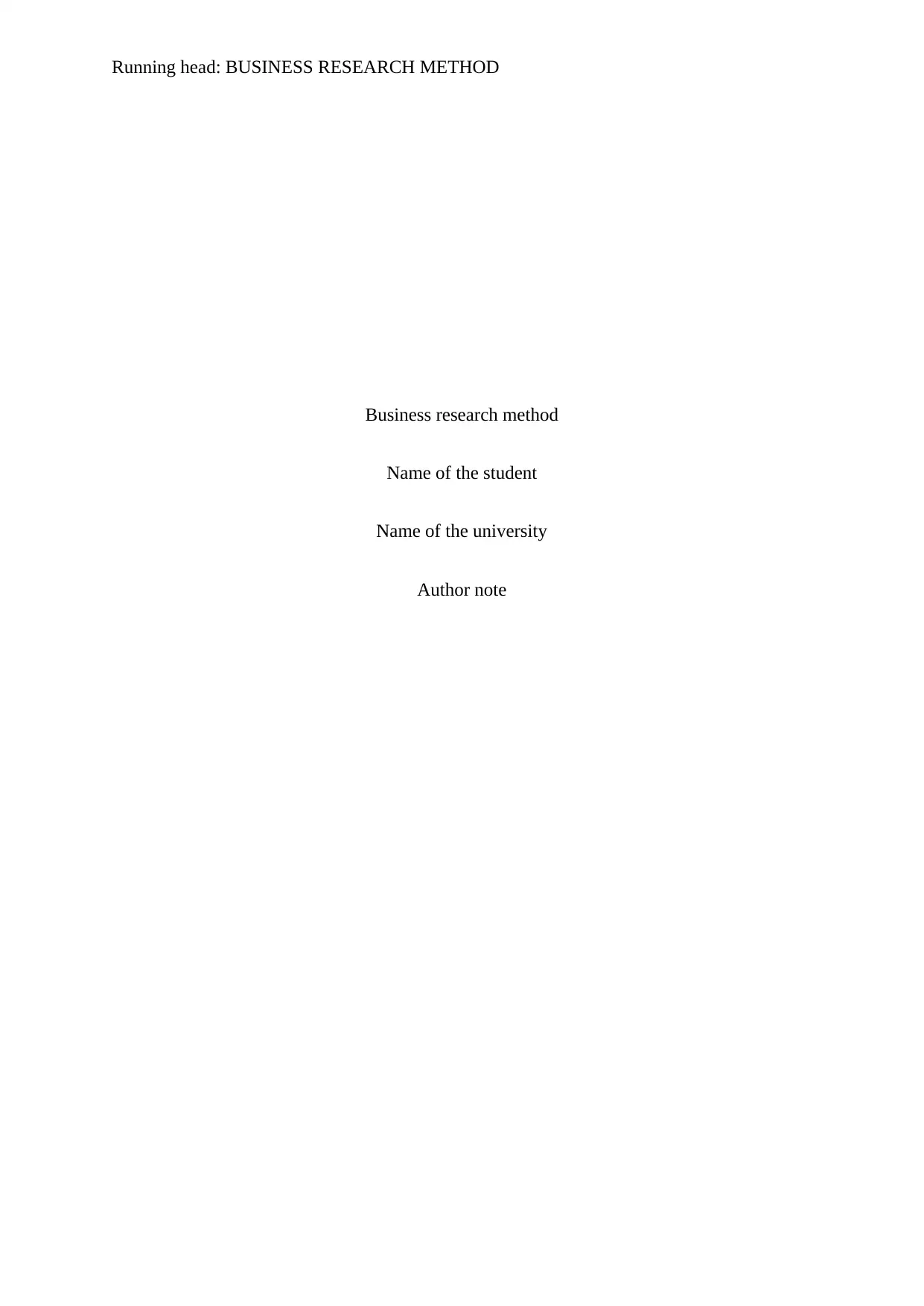
Running head: BUSINESS RESEARCH METHOD
Business research method
Name of the student
Name of the university
Author note
Business research method
Name of the student
Name of the university
Author note
Paraphrase This Document
Need a fresh take? Get an instant paraphrase of this document with our AI Paraphraser
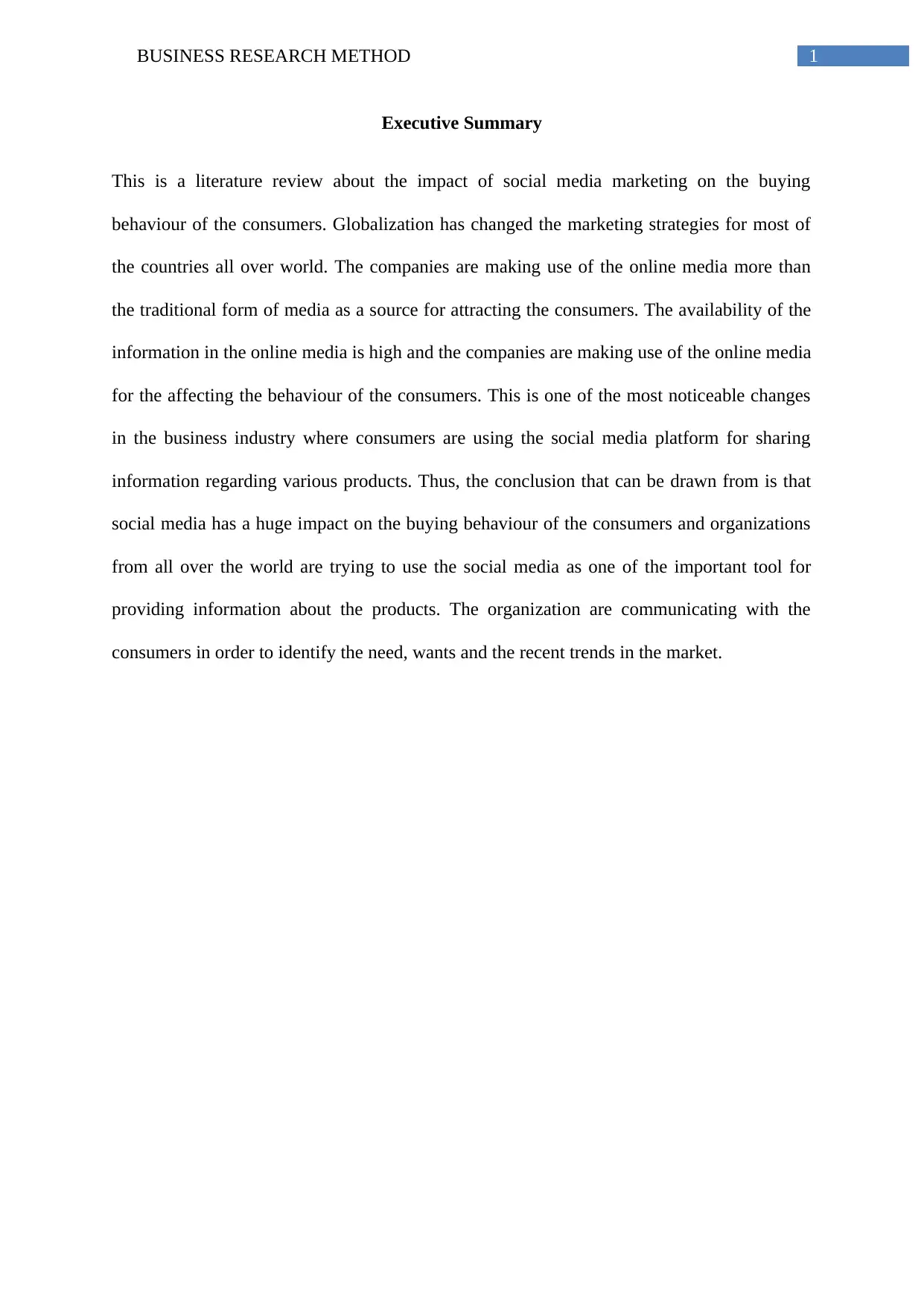
1BUSINESS RESEARCH METHOD
Executive Summary
This is a literature review about the impact of social media marketing on the buying
behaviour of the consumers. Globalization has changed the marketing strategies for most of
the countries all over world. The companies are making use of the online media more than
the traditional form of media as a source for attracting the consumers. The availability of the
information in the online media is high and the companies are making use of the online media
for the affecting the behaviour of the consumers. This is one of the most noticeable changes
in the business industry where consumers are using the social media platform for sharing
information regarding various products. Thus, the conclusion that can be drawn from is that
social media has a huge impact on the buying behaviour of the consumers and organizations
from all over the world are trying to use the social media as one of the important tool for
providing information about the products. The organization are communicating with the
consumers in order to identify the need, wants and the recent trends in the market.
Executive Summary
This is a literature review about the impact of social media marketing on the buying
behaviour of the consumers. Globalization has changed the marketing strategies for most of
the countries all over world. The companies are making use of the online media more than
the traditional form of media as a source for attracting the consumers. The availability of the
information in the online media is high and the companies are making use of the online media
for the affecting the behaviour of the consumers. This is one of the most noticeable changes
in the business industry where consumers are using the social media platform for sharing
information regarding various products. Thus, the conclusion that can be drawn from is that
social media has a huge impact on the buying behaviour of the consumers and organizations
from all over the world are trying to use the social media as one of the important tool for
providing information about the products. The organization are communicating with the
consumers in order to identify the need, wants and the recent trends in the market.
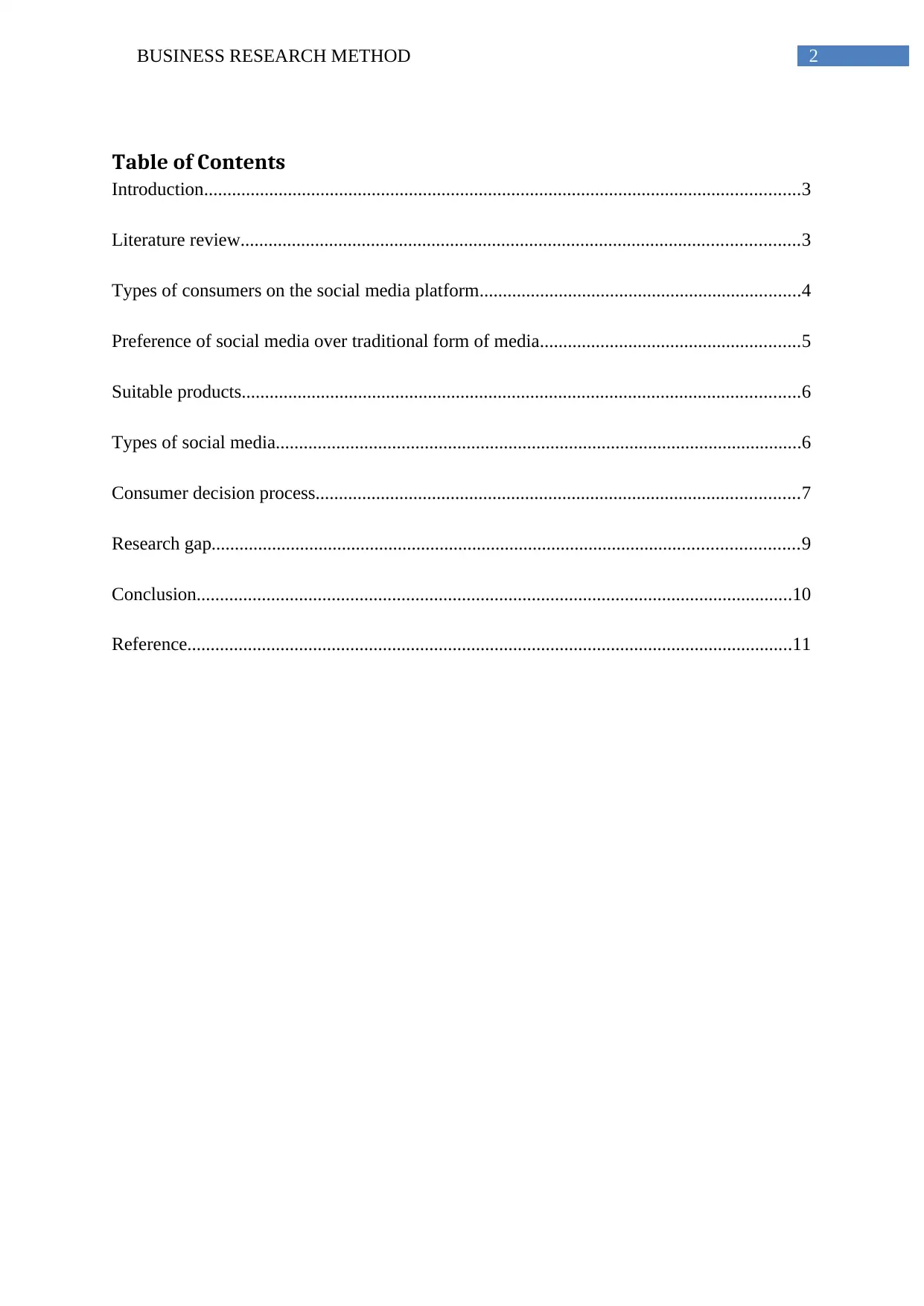
2BUSINESS RESEARCH METHOD
Table of Contents
Introduction................................................................................................................................3
Literature review........................................................................................................................3
Types of consumers on the social media platform.....................................................................4
Preference of social media over traditional form of media........................................................5
Suitable products........................................................................................................................6
Types of social media.................................................................................................................6
Consumer decision process........................................................................................................7
Research gap..............................................................................................................................9
Conclusion................................................................................................................................10
Reference..................................................................................................................................11
Table of Contents
Introduction................................................................................................................................3
Literature review........................................................................................................................3
Types of consumers on the social media platform.....................................................................4
Preference of social media over traditional form of media........................................................5
Suitable products........................................................................................................................6
Types of social media.................................................................................................................6
Consumer decision process........................................................................................................7
Research gap..............................................................................................................................9
Conclusion................................................................................................................................10
Reference..................................................................................................................................11
⊘ This is a preview!⊘
Do you want full access?
Subscribe today to unlock all pages.

Trusted by 1+ million students worldwide
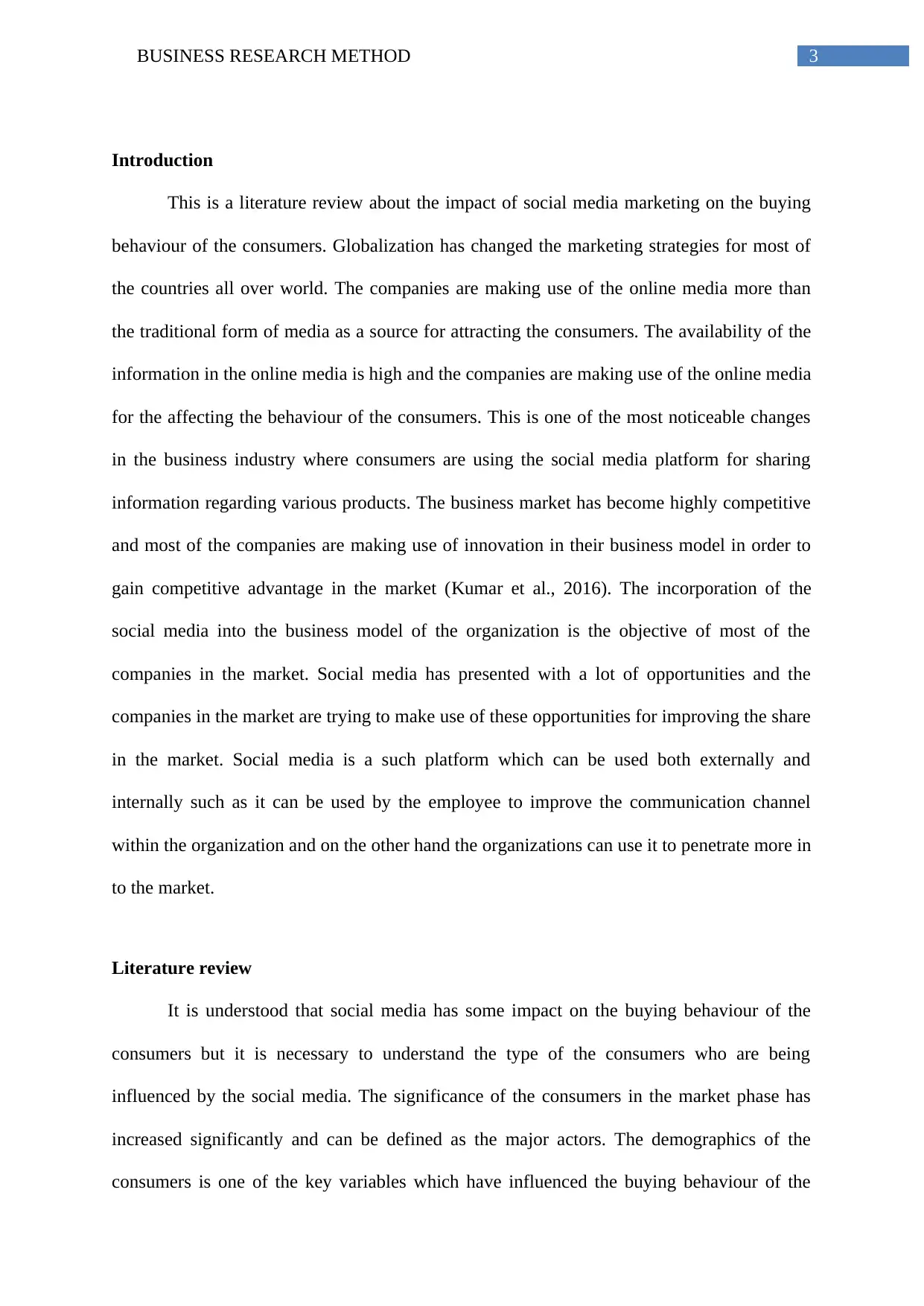
3BUSINESS RESEARCH METHOD
Introduction
This is a literature review about the impact of social media marketing on the buying
behaviour of the consumers. Globalization has changed the marketing strategies for most of
the countries all over world. The companies are making use of the online media more than
the traditional form of media as a source for attracting the consumers. The availability of the
information in the online media is high and the companies are making use of the online media
for the affecting the behaviour of the consumers. This is one of the most noticeable changes
in the business industry where consumers are using the social media platform for sharing
information regarding various products. The business market has become highly competitive
and most of the companies are making use of innovation in their business model in order to
gain competitive advantage in the market (Kumar et al., 2016). The incorporation of the
social media into the business model of the organization is the objective of most of the
companies in the market. Social media has presented with a lot of opportunities and the
companies in the market are trying to make use of these opportunities for improving the share
in the market. Social media is a such platform which can be used both externally and
internally such as it can be used by the employee to improve the communication channel
within the organization and on the other hand the organizations can use it to penetrate more in
to the market.
Literature review
It is understood that social media has some impact on the buying behaviour of the
consumers but it is necessary to understand the type of the consumers who are being
influenced by the social media. The significance of the consumers in the market phase has
increased significantly and can be defined as the major actors. The demographics of the
consumers is one of the key variables which have influenced the buying behaviour of the
Introduction
This is a literature review about the impact of social media marketing on the buying
behaviour of the consumers. Globalization has changed the marketing strategies for most of
the countries all over world. The companies are making use of the online media more than
the traditional form of media as a source for attracting the consumers. The availability of the
information in the online media is high and the companies are making use of the online media
for the affecting the behaviour of the consumers. This is one of the most noticeable changes
in the business industry where consumers are using the social media platform for sharing
information regarding various products. The business market has become highly competitive
and most of the companies are making use of innovation in their business model in order to
gain competitive advantage in the market (Kumar et al., 2016). The incorporation of the
social media into the business model of the organization is the objective of most of the
companies in the market. Social media has presented with a lot of opportunities and the
companies in the market are trying to make use of these opportunities for improving the share
in the market. Social media is a such platform which can be used both externally and
internally such as it can be used by the employee to improve the communication channel
within the organization and on the other hand the organizations can use it to penetrate more in
to the market.
Literature review
It is understood that social media has some impact on the buying behaviour of the
consumers but it is necessary to understand the type of the consumers who are being
influenced by the social media. The significance of the consumers in the market phase has
increased significantly and can be defined as the major actors. The demographics of the
consumers is one of the key variables which have influenced the buying behaviour of the
Paraphrase This Document
Need a fresh take? Get an instant paraphrase of this document with our AI Paraphraser
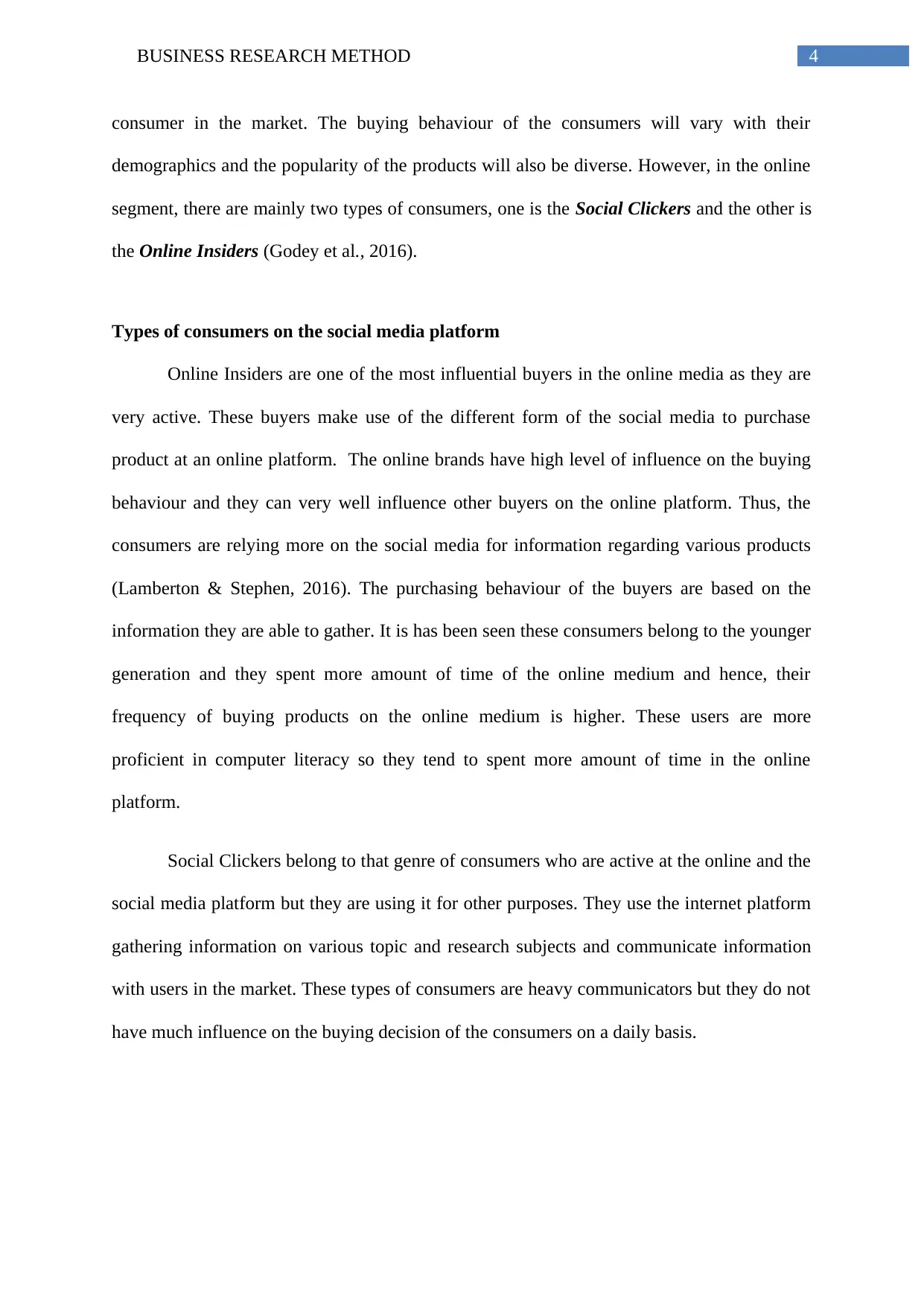
4BUSINESS RESEARCH METHOD
consumer in the market. The buying behaviour of the consumers will vary with their
demographics and the popularity of the products will also be diverse. However, in the online
segment, there are mainly two types of consumers, one is the Social Clickers and the other is
the Online Insiders (Godey et al., 2016).
Types of consumers on the social media platform
Online Insiders are one of the most influential buyers in the online media as they are
very active. These buyers make use of the different form of the social media to purchase
product at an online platform. The online brands have high level of influence on the buying
behaviour and they can very well influence other buyers on the online platform. Thus, the
consumers are relying more on the social media for information regarding various products
(Lamberton & Stephen, 2016). The purchasing behaviour of the buyers are based on the
information they are able to gather. It is has been seen these consumers belong to the younger
generation and they spent more amount of time of the online medium and hence, their
frequency of buying products on the online medium is higher. These users are more
proficient in computer literacy so they tend to spent more amount of time in the online
platform.
Social Clickers belong to that genre of consumers who are active at the online and the
social media platform but they are using it for other purposes. They use the internet platform
gathering information on various topic and research subjects and communicate information
with users in the market. These types of consumers are heavy communicators but they do not
have much influence on the buying decision of the consumers on a daily basis.
consumer in the market. The buying behaviour of the consumers will vary with their
demographics and the popularity of the products will also be diverse. However, in the online
segment, there are mainly two types of consumers, one is the Social Clickers and the other is
the Online Insiders (Godey et al., 2016).
Types of consumers on the social media platform
Online Insiders are one of the most influential buyers in the online media as they are
very active. These buyers make use of the different form of the social media to purchase
product at an online platform. The online brands have high level of influence on the buying
behaviour and they can very well influence other buyers on the online platform. Thus, the
consumers are relying more on the social media for information regarding various products
(Lamberton & Stephen, 2016). The purchasing behaviour of the buyers are based on the
information they are able to gather. It is has been seen these consumers belong to the younger
generation and they spent more amount of time of the online medium and hence, their
frequency of buying products on the online medium is higher. These users are more
proficient in computer literacy so they tend to spent more amount of time in the online
platform.
Social Clickers belong to that genre of consumers who are active at the online and the
social media platform but they are using it for other purposes. They use the internet platform
gathering information on various topic and research subjects and communicate information
with users in the market. These types of consumers are heavy communicators but they do not
have much influence on the buying decision of the consumers on a daily basis.
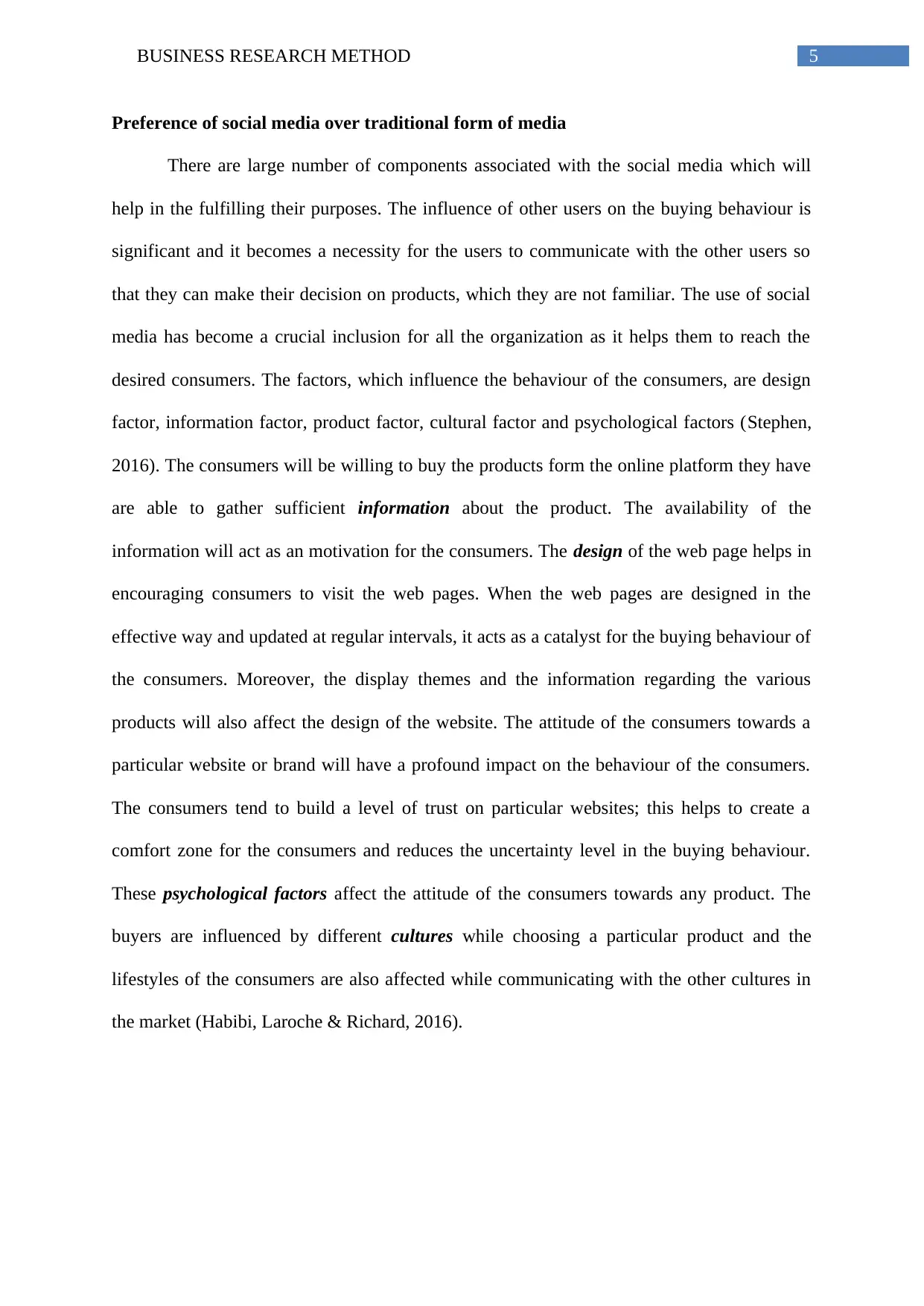
5BUSINESS RESEARCH METHOD
Preference of social media over traditional form of media
There are large number of components associated with the social media which will
help in the fulfilling their purposes. The influence of other users on the buying behaviour is
significant and it becomes a necessity for the users to communicate with the other users so
that they can make their decision on products, which they are not familiar. The use of social
media has become a crucial inclusion for all the organization as it helps them to reach the
desired consumers. The factors, which influence the behaviour of the consumers, are design
factor, information factor, product factor, cultural factor and psychological factors (Stephen,
2016). The consumers will be willing to buy the products form the online platform they have
are able to gather sufficient information about the product. The availability of the
information will act as an motivation for the consumers. The design of the web page helps in
encouraging consumers to visit the web pages. When the web pages are designed in the
effective way and updated at regular intervals, it acts as a catalyst for the buying behaviour of
the consumers. Moreover, the display themes and the information regarding the various
products will also affect the design of the website. The attitude of the consumers towards a
particular website or brand will have a profound impact on the behaviour of the consumers.
The consumers tend to build a level of trust on particular websites; this helps to create a
comfort zone for the consumers and reduces the uncertainty level in the buying behaviour.
These psychological factors affect the attitude of the consumers towards any product. The
buyers are influenced by different cultures while choosing a particular product and the
lifestyles of the consumers are also affected while communicating with the other cultures in
the market (Habibi, Laroche & Richard, 2016).
Preference of social media over traditional form of media
There are large number of components associated with the social media which will
help in the fulfilling their purposes. The influence of other users on the buying behaviour is
significant and it becomes a necessity for the users to communicate with the other users so
that they can make their decision on products, which they are not familiar. The use of social
media has become a crucial inclusion for all the organization as it helps them to reach the
desired consumers. The factors, which influence the behaviour of the consumers, are design
factor, information factor, product factor, cultural factor and psychological factors (Stephen,
2016). The consumers will be willing to buy the products form the online platform they have
are able to gather sufficient information about the product. The availability of the
information will act as an motivation for the consumers. The design of the web page helps in
encouraging consumers to visit the web pages. When the web pages are designed in the
effective way and updated at regular intervals, it acts as a catalyst for the buying behaviour of
the consumers. Moreover, the display themes and the information regarding the various
products will also affect the design of the website. The attitude of the consumers towards a
particular website or brand will have a profound impact on the behaviour of the consumers.
The consumers tend to build a level of trust on particular websites; this helps to create a
comfort zone for the consumers and reduces the uncertainty level in the buying behaviour.
These psychological factors affect the attitude of the consumers towards any product. The
buyers are influenced by different cultures while choosing a particular product and the
lifestyles of the consumers are also affected while communicating with the other cultures in
the market (Habibi, Laroche & Richard, 2016).
⊘ This is a preview!⊘
Do you want full access?
Subscribe today to unlock all pages.

Trusted by 1+ million students worldwide

6BUSINESS RESEARCH METHOD
Suitable products
Various researchers and scholars have conducted to analyze the products and services,
which are ideal for selling in an online platform. There are mainly two types of products; one
is the intangible products and the other is the tangible products. The intangible products in
the online platform include music, online videos, computer software, financial report, stock
market and weather information. The tangible products in the social media platform include
electronic devices, accessories, jewelleries, flowers and automobiles.
Types of social media
There are mainly three types of social media websites, which are used, by the
consumers as well as the organization to share information regarding various products in the
market. As put forward by Hajli, (2014), the number of consumers in the social media
platform is increasing at an rapid rate and majority of the consumers are preferring to use the
social media for gathering information about various products. These platforms are even used
for sharing information among the various users in the market. Facebook consist of millions
of consumers who are very active and eager to share information regarding various products
in the market. The study suggest that the majority of the users in Facebook have the
capability of the providing other users with the information about various products in the
market. The users in Facebook follow their preferred brands, which helps them to gain
knowledge about the various brands and their respective products. Twitter has been gaining
more and more popularity and the number of followers in the micro blogging site is
increasing at a rapid rate (Ioanăs & Stoica, 2014). The users tend to show their appreciation
regarding various products in the market and the reviews provided by lot of users helps in
providing information about unknown products to the other users. Moreover, more than half
of the users in the market are using Twitter as a platform to make purchase of different
Suitable products
Various researchers and scholars have conducted to analyze the products and services,
which are ideal for selling in an online platform. There are mainly two types of products; one
is the intangible products and the other is the tangible products. The intangible products in
the online platform include music, online videos, computer software, financial report, stock
market and weather information. The tangible products in the social media platform include
electronic devices, accessories, jewelleries, flowers and automobiles.
Types of social media
There are mainly three types of social media websites, which are used, by the
consumers as well as the organization to share information regarding various products in the
market. As put forward by Hajli, (2014), the number of consumers in the social media
platform is increasing at an rapid rate and majority of the consumers are preferring to use the
social media for gathering information about various products. These platforms are even used
for sharing information among the various users in the market. Facebook consist of millions
of consumers who are very active and eager to share information regarding various products
in the market. The study suggest that the majority of the users in Facebook have the
capability of the providing other users with the information about various products in the
market. The users in Facebook follow their preferred brands, which helps them to gain
knowledge about the various brands and their respective products. Twitter has been gaining
more and more popularity and the number of followers in the micro blogging site is
increasing at a rapid rate (Ioanăs & Stoica, 2014). The users tend to show their appreciation
regarding various products in the market and the reviews provided by lot of users helps in
providing information about unknown products to the other users. Moreover, more than half
of the users in the market are using Twitter as a platform to make purchase of different
Paraphrase This Document
Need a fresh take? Get an instant paraphrase of this document with our AI Paraphraser
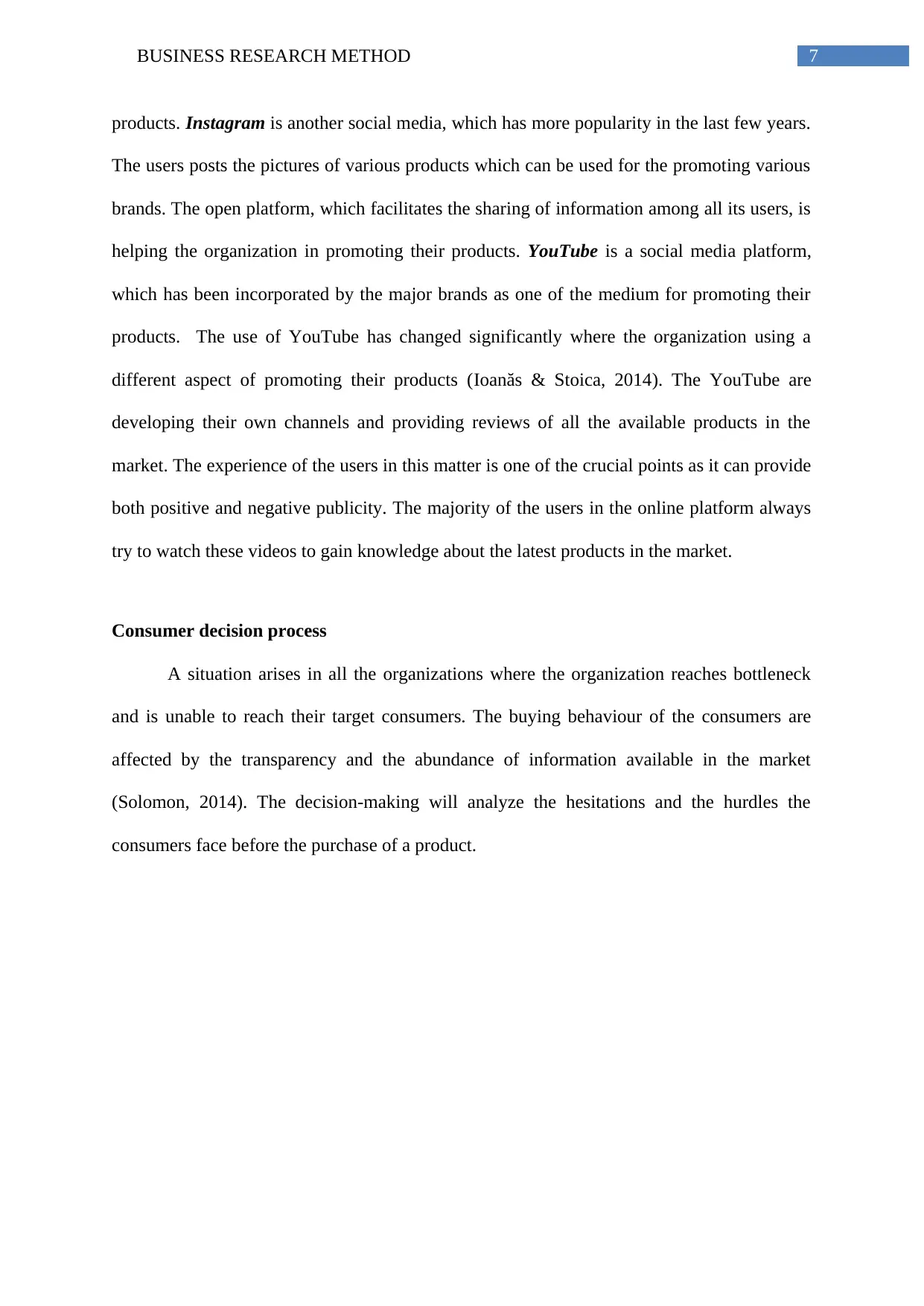
7BUSINESS RESEARCH METHOD
products. Instagram is another social media, which has more popularity in the last few years.
The users posts the pictures of various products which can be used for the promoting various
brands. The open platform, which facilitates the sharing of information among all its users, is
helping the organization in promoting their products. YouTube is a social media platform,
which has been incorporated by the major brands as one of the medium for promoting their
products. The use of YouTube has changed significantly where the organization using a
different aspect of promoting their products (Ioanăs & Stoica, 2014). The YouTube are
developing their own channels and providing reviews of all the available products in the
market. The experience of the users in this matter is one of the crucial points as it can provide
both positive and negative publicity. The majority of the users in the online platform always
try to watch these videos to gain knowledge about the latest products in the market.
Consumer decision process
A situation arises in all the organizations where the organization reaches bottleneck
and is unable to reach their target consumers. The buying behaviour of the consumers are
affected by the transparency and the abundance of information available in the market
(Solomon, 2014). The decision-making will analyze the hesitations and the hurdles the
consumers face before the purchase of a product.
products. Instagram is another social media, which has more popularity in the last few years.
The users posts the pictures of various products which can be used for the promoting various
brands. The open platform, which facilitates the sharing of information among all its users, is
helping the organization in promoting their products. YouTube is a social media platform,
which has been incorporated by the major brands as one of the medium for promoting their
products. The use of YouTube has changed significantly where the organization using a
different aspect of promoting their products (Ioanăs & Stoica, 2014). The YouTube are
developing their own channels and providing reviews of all the available products in the
market. The experience of the users in this matter is one of the crucial points as it can provide
both positive and negative publicity. The majority of the users in the online platform always
try to watch these videos to gain knowledge about the latest products in the market.
Consumer decision process
A situation arises in all the organizations where the organization reaches bottleneck
and is unable to reach their target consumers. The buying behaviour of the consumers are
affected by the transparency and the abundance of information available in the market
(Solomon, 2014). The decision-making will analyze the hesitations and the hurdles the
consumers face before the purchase of a product.

8BUSINESS RESEARCH METHOD
Figure 1
(Source: Solomon, 2014)
The most important aspects in the decision-making procedure are explained using the
above model. The behaviour pattern of every consumer can be identified by using this model.
The five stages of the decision making process are recognition of need, information
searching, alternatives evaluation, decision of purchase and post purchase decision. The
buying behaviour of any consumer starts with the generation of need and this need will cause
the consumer to commence the procedure for gathering of information (Wen et al., 2014).
There are both internal and external factors, which cause the generation of need recognition
of the consumer. Television advertisements and information available information of the
social media may trigger the need of buying a product. the products offered by the
organization will have to cater to the needs of the consumers so that it can grab the attention
of the consumers in the market. Even after the generation of the need by the consumers,
there is a long process even after the recognition of the need (Maity & Dass, 2014). The
internal sources will include the previous and personal experience of the consumers with a
Figure 1
(Source: Solomon, 2014)
The most important aspects in the decision-making procedure are explained using the
above model. The behaviour pattern of every consumer can be identified by using this model.
The five stages of the decision making process are recognition of need, information
searching, alternatives evaluation, decision of purchase and post purchase decision. The
buying behaviour of any consumer starts with the generation of need and this need will cause
the consumer to commence the procedure for gathering of information (Wen et al., 2014).
There are both internal and external factors, which cause the generation of need recognition
of the consumer. Television advertisements and information available information of the
social media may trigger the need of buying a product. the products offered by the
organization will have to cater to the needs of the consumers so that it can grab the attention
of the consumers in the market. Even after the generation of the need by the consumers,
there is a long process even after the recognition of the need (Maity & Dass, 2014). The
internal sources will include the previous and personal experience of the consumers with a
⊘ This is a preview!⊘
Do you want full access?
Subscribe today to unlock all pages.

Trusted by 1+ million students worldwide
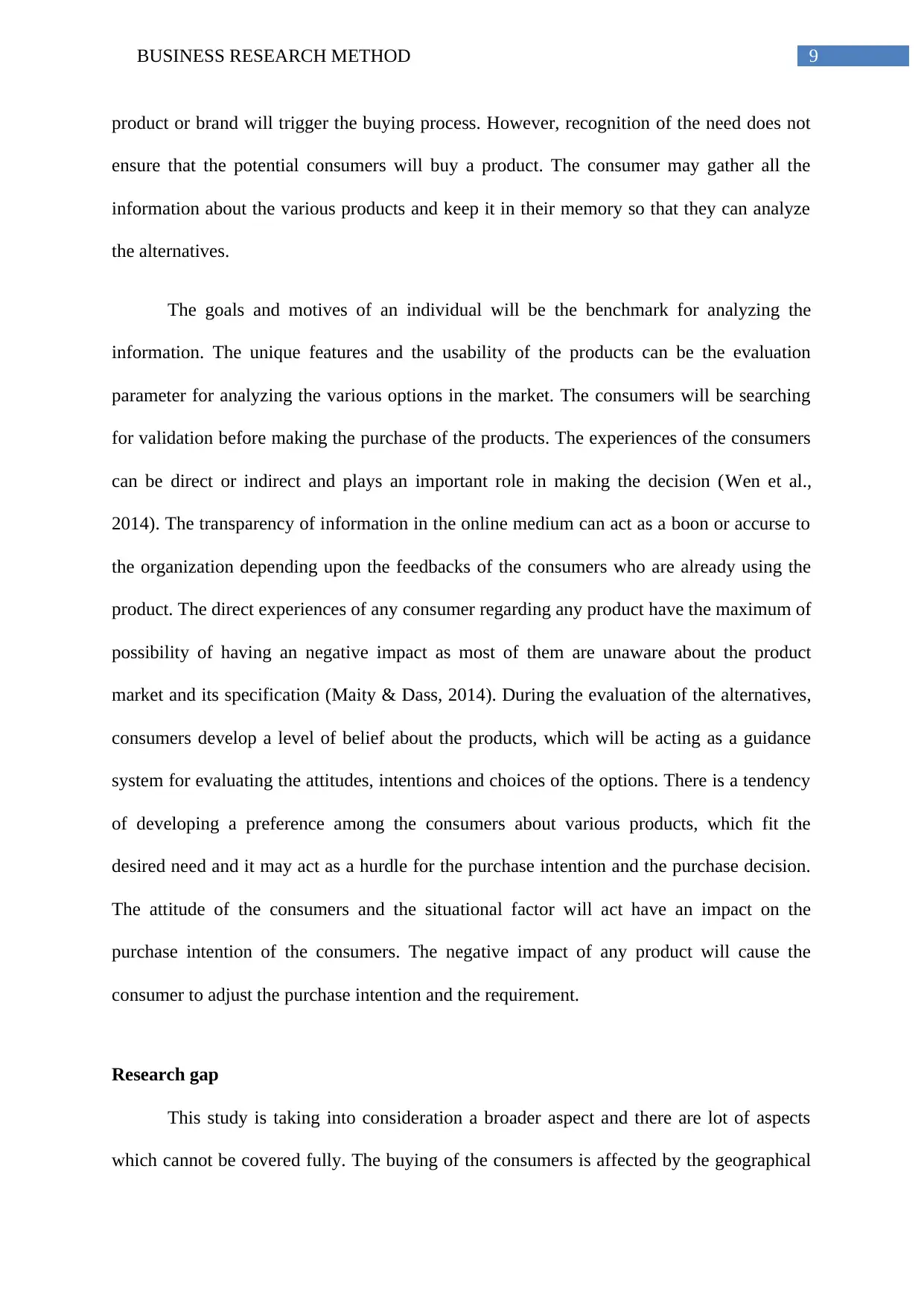
9BUSINESS RESEARCH METHOD
product or brand will trigger the buying process. However, recognition of the need does not
ensure that the potential consumers will buy a product. The consumer may gather all the
information about the various products and keep it in their memory so that they can analyze
the alternatives.
The goals and motives of an individual will be the benchmark for analyzing the
information. The unique features and the usability of the products can be the evaluation
parameter for analyzing the various options in the market. The consumers will be searching
for validation before making the purchase of the products. The experiences of the consumers
can be direct or indirect and plays an important role in making the decision (Wen et al.,
2014). The transparency of information in the online medium can act as a boon or accurse to
the organization depending upon the feedbacks of the consumers who are already using the
product. The direct experiences of any consumer regarding any product have the maximum of
possibility of having an negative impact as most of them are unaware about the product
market and its specification (Maity & Dass, 2014). During the evaluation of the alternatives,
consumers develop a level of belief about the products, which will be acting as a guidance
system for evaluating the attitudes, intentions and choices of the options. There is a tendency
of developing a preference among the consumers about various products, which fit the
desired need and it may act as a hurdle for the purchase intention and the purchase decision.
The attitude of the consumers and the situational factor will act have an impact on the
purchase intention of the consumers. The negative impact of any product will cause the
consumer to adjust the purchase intention and the requirement.
Research gap
This study is taking into consideration a broader aspect and there are lot of aspects
which cannot be covered fully. The buying of the consumers is affected by the geographical
product or brand will trigger the buying process. However, recognition of the need does not
ensure that the potential consumers will buy a product. The consumer may gather all the
information about the various products and keep it in their memory so that they can analyze
the alternatives.
The goals and motives of an individual will be the benchmark for analyzing the
information. The unique features and the usability of the products can be the evaluation
parameter for analyzing the various options in the market. The consumers will be searching
for validation before making the purchase of the products. The experiences of the consumers
can be direct or indirect and plays an important role in making the decision (Wen et al.,
2014). The transparency of information in the online medium can act as a boon or accurse to
the organization depending upon the feedbacks of the consumers who are already using the
product. The direct experiences of any consumer regarding any product have the maximum of
possibility of having an negative impact as most of them are unaware about the product
market and its specification (Maity & Dass, 2014). During the evaluation of the alternatives,
consumers develop a level of belief about the products, which will be acting as a guidance
system for evaluating the attitudes, intentions and choices of the options. There is a tendency
of developing a preference among the consumers about various products, which fit the
desired need and it may act as a hurdle for the purchase intention and the purchase decision.
The attitude of the consumers and the situational factor will act have an impact on the
purchase intention of the consumers. The negative impact of any product will cause the
consumer to adjust the purchase intention and the requirement.
Research gap
This study is taking into consideration a broader aspect and there are lot of aspects
which cannot be covered fully. The buying of the consumers is affected by the geographical
Paraphrase This Document
Need a fresh take? Get an instant paraphrase of this document with our AI Paraphraser
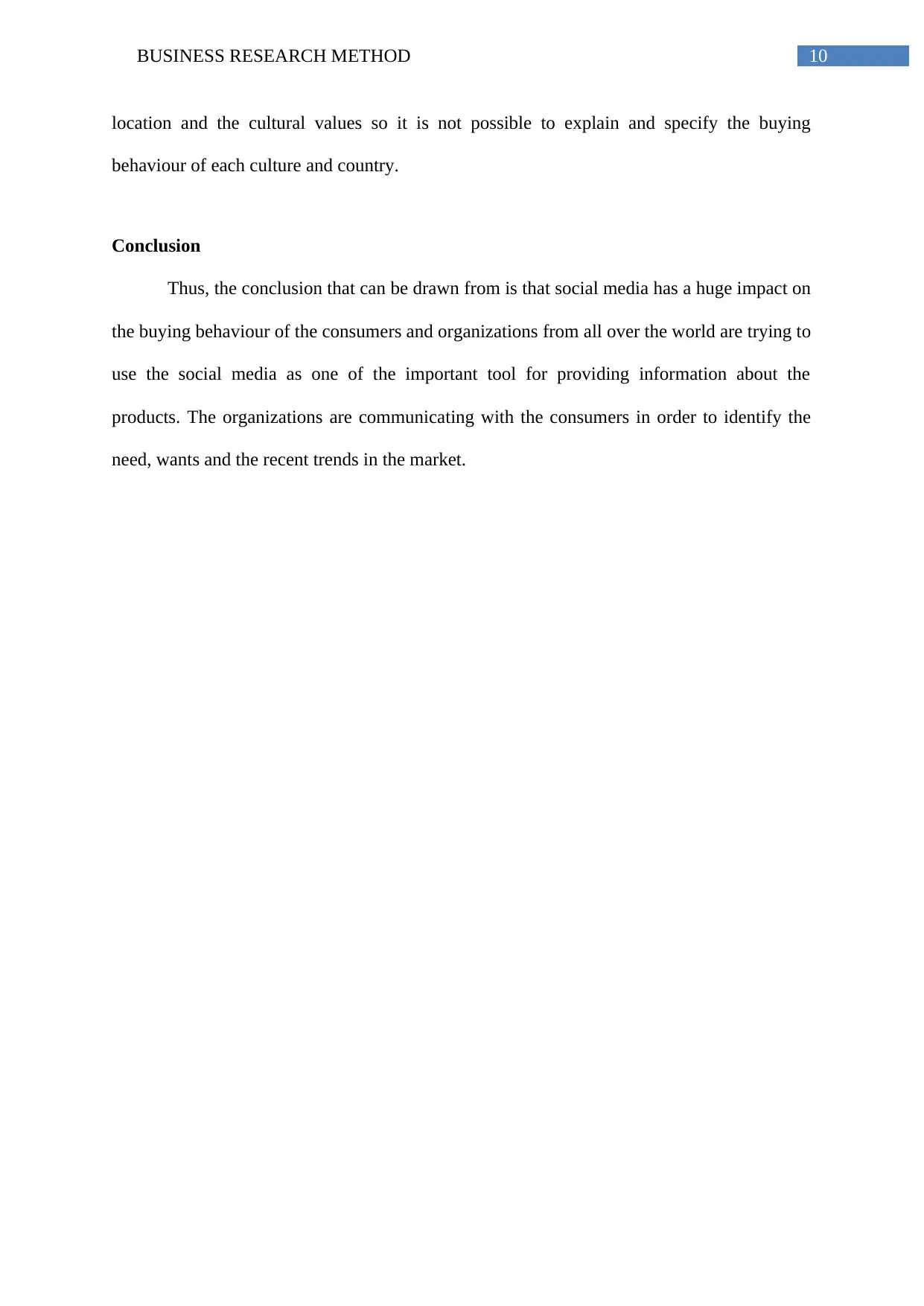
10BUSINESS RESEARCH METHOD
location and the cultural values so it is not possible to explain and specify the buying
behaviour of each culture and country.
Conclusion
Thus, the conclusion that can be drawn from is that social media has a huge impact on
the buying behaviour of the consumers and organizations from all over the world are trying to
use the social media as one of the important tool for providing information about the
products. The organizations are communicating with the consumers in order to identify the
need, wants and the recent trends in the market.
location and the cultural values so it is not possible to explain and specify the buying
behaviour of each culture and country.
Conclusion
Thus, the conclusion that can be drawn from is that social media has a huge impact on
the buying behaviour of the consumers and organizations from all over the world are trying to
use the social media as one of the important tool for providing information about the
products. The organizations are communicating with the consumers in order to identify the
need, wants and the recent trends in the market.
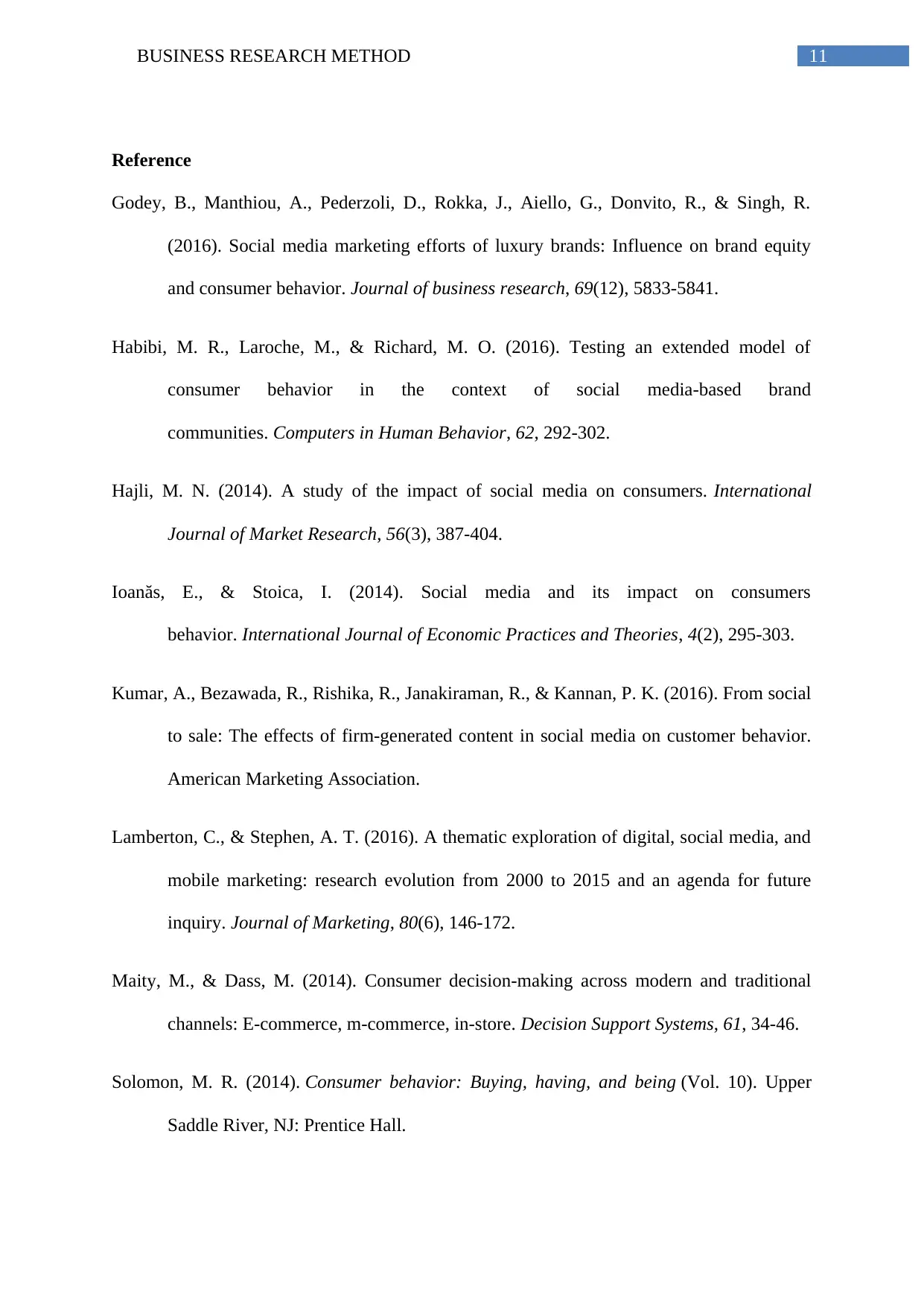
11BUSINESS RESEARCH METHOD
Reference
Godey, B., Manthiou, A., Pederzoli, D., Rokka, J., Aiello, G., Donvito, R., & Singh, R.
(2016). Social media marketing efforts of luxury brands: Influence on brand equity
and consumer behavior. Journal of business research, 69(12), 5833-5841.
Habibi, M. R., Laroche, M., & Richard, M. O. (2016). Testing an extended model of
consumer behavior in the context of social media-based brand
communities. Computers in Human Behavior, 62, 292-302.
Hajli, M. N. (2014). A study of the impact of social media on consumers. International
Journal of Market Research, 56(3), 387-404.
Ioanăs, E., & Stoica, I. (2014). Social media and its impact on consumers
behavior. International Journal of Economic Practices and Theories, 4(2), 295-303.
Kumar, A., Bezawada, R., Rishika, R., Janakiraman, R., & Kannan, P. K. (2016). From social
to sale: The effects of firm-generated content in social media on customer behavior.
American Marketing Association.
Lamberton, C., & Stephen, A. T. (2016). A thematic exploration of digital, social media, and
mobile marketing: research evolution from 2000 to 2015 and an agenda for future
inquiry. Journal of Marketing, 80(6), 146-172.
Maity, M., & Dass, M. (2014). Consumer decision-making across modern and traditional
channels: E-commerce, m-commerce, in-store. Decision Support Systems, 61, 34-46.
Solomon, M. R. (2014). Consumer behavior: Buying, having, and being (Vol. 10). Upper
Saddle River, NJ: Prentice Hall.
Reference
Godey, B., Manthiou, A., Pederzoli, D., Rokka, J., Aiello, G., Donvito, R., & Singh, R.
(2016). Social media marketing efforts of luxury brands: Influence on brand equity
and consumer behavior. Journal of business research, 69(12), 5833-5841.
Habibi, M. R., Laroche, M., & Richard, M. O. (2016). Testing an extended model of
consumer behavior in the context of social media-based brand
communities. Computers in Human Behavior, 62, 292-302.
Hajli, M. N. (2014). A study of the impact of social media on consumers. International
Journal of Market Research, 56(3), 387-404.
Ioanăs, E., & Stoica, I. (2014). Social media and its impact on consumers
behavior. International Journal of Economic Practices and Theories, 4(2), 295-303.
Kumar, A., Bezawada, R., Rishika, R., Janakiraman, R., & Kannan, P. K. (2016). From social
to sale: The effects of firm-generated content in social media on customer behavior.
American Marketing Association.
Lamberton, C., & Stephen, A. T. (2016). A thematic exploration of digital, social media, and
mobile marketing: research evolution from 2000 to 2015 and an agenda for future
inquiry. Journal of Marketing, 80(6), 146-172.
Maity, M., & Dass, M. (2014). Consumer decision-making across modern and traditional
channels: E-commerce, m-commerce, in-store. Decision Support Systems, 61, 34-46.
Solomon, M. R. (2014). Consumer behavior: Buying, having, and being (Vol. 10). Upper
Saddle River, NJ: Prentice Hall.
⊘ This is a preview!⊘
Do you want full access?
Subscribe today to unlock all pages.

Trusted by 1+ million students worldwide
1 out of 13
Related Documents
Your All-in-One AI-Powered Toolkit for Academic Success.
+13062052269
info@desklib.com
Available 24*7 on WhatsApp / Email
![[object Object]](/_next/static/media/star-bottom.7253800d.svg)
Unlock your academic potential
Copyright © 2020–2026 A2Z Services. All Rights Reserved. Developed and managed by ZUCOL.





